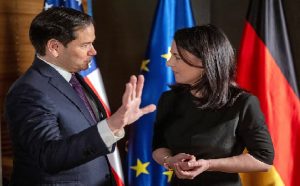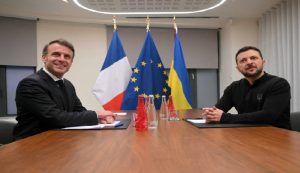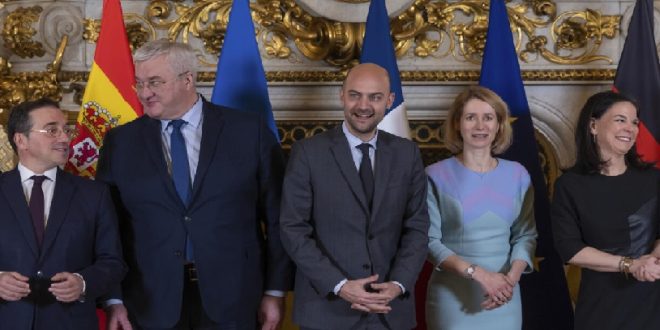19-02-2025
MUNICH: Ever since World War Two ended, Europe has been able to stand up to Russia by relying on its big brother in the United States but now it is confronted by a strongman in the White House, US President Donald Trump, as well as one in the Kremlin, Russian President Vladimir Putin. Its capacity to withstand both will depend on money, determination, and political unity.
 Whether Europe can stand up to the US and Russia at the same time is the central question facing select leaders French President Emmanuel Macron has invited to a summit in Paris on Monday. It will not be easy. Europe is weak and divided but European Union countries, as well as those outside the bloc such as the United Kingdom, may be yet able to hold their own if they work together decisively.
Whether Europe can stand up to the US and Russia at the same time is the central question facing select leaders French President Emmanuel Macron has invited to a summit in Paris on Monday. It will not be easy. Europe is weak and divided but European Union countries, as well as those outside the bloc such as the United Kingdom, may be yet able to hold their own if they work together decisively.
Europe’s perilous position has become crystal clear over the past week. Trump called Putin to kick off peace talks over Ukraine before phoning its president Volodymyr Zelenskiy. The US envoy to Ukraine, Keith Kellogg, then made clear that America sees no role for Europe in the peace talks which will begin in Saudi Arabia this week. The risk is that Trump will agree a deal that amounts to capitulation by Kyiv and present it as a fait accompli.
Meanwhile, US defence secretary Pete Hegseth told European NATO allies they would have to assume greater responsibility for their own security as the United States was no longer “primarily focused” on it. Then US Vice President JD Vance accused Europe’s governments of censoring free speech and far-right politicians. As if that was not enough, Trump threatened, opens new tab “reciprocal” tariffs against all countries that charge higher trade levies than the US this could hit Europe hard given that the president wrongly views value-added taxes, which are high in Europe, as equivalent to tariffs.
 Europe’s top priority should be to stop Trump selling Ukraine down the river. Although its chance of doing that is slim, its best bet is to commit to provide the lion’s share of the security support that Ukraine will need if there is a ceasefire pact but only if European countries and Kyiv agree to the deal.
Europe’s top priority should be to stop Trump selling Ukraine down the river. Although its chance of doing that is slim, its best bet is to commit to provide the lion’s share of the security support that Ukraine will need if there is a ceasefire pact but only if European countries and Kyiv agree to the deal.
There are two obvious difficulties with such an approach. One is that European nations do not have many troops and some such as Poland want to keep their soldiers at home to defend against a possible attack from Russia. Another is that Putin will say “no” and Trump may accede to his Russian counterpart’s demands.
So while it is worth Europe trying to stiffen the US president’s spine, it needs a fallback plan if Trump tries to impose a deal that Ukraine finds unacceptable. Europe’s least bad bet, in this scenario, would be to step up its military and financial support for Kyiv.
This Plan B has two problems of its own. One is that Europe will struggle to fill the gap if the Trump administration abandons Ukraine. The continent is not producing arms nearly rapidly enough to replace American supplies and will struggle to replicate military capabilities such as the last-minute intelligence that the United States gives Ukraine to help it target Russian forces accurately. Even if Europe tries its best, Kyiv could still end up losing the war.
Another problem is that Trump may get angry with Europe if it undermines a deal with Putin. The president may lift US sanctions on Russia, which would help the Kremlin refill its war chest. He may also threaten European leaders that they are on their own in the event of a Russian attack.
All that said, Trump will want to avoid the impression he is ditching Ukraine while Europe stands by it and that may just persuade him to hang tough in negotiations but Europe cannot count on this. So it will also need to develop a Plan C. (Int’l News Desk)
 Pressmediaofindia
Pressmediaofindia




